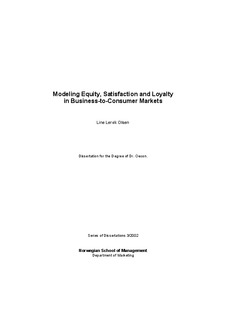Modeling Equity, Satisfaction and Loyalty
Abstract
The link between customer satisfaction and loyalty has had a tremendous impact on managerial decision-making and academic works over the years. Despite the lack of empirical research supporting this link, its existence seems to be assumed, independent of place and time. Across customer loyalty studies, however, the achieved explained variance in the customer loyalty construct is typically rather low, indicating other possible explanations than customer satisfaction to account for customers’ loyalty to service providers.
At the same time, we observe that customers’ demands are changing at an increasingly high pace; customers now expect to interact with service providers in a multitude of ways simultaneously, posing new challenges to service managers striving to establish and maintain a loyal customer base. Triggered by marketing’s shift in focus from a transaction to a relationship orientation, this development has further escalated due to the rapid infusion of new technology into service industries, demonstrating as such the need to explore alternative determinants of customer loyalty in various situations.
In the literature, alternative determinants or intervening variables have been classified as intra-psychological, contextual or situational factors; in this dissertation, we investigate such alternative determinants and intervening variables in order to explain customer loyalty in various situations. The overall research objective of the dissertation has been, then, to gain insight into the consequences for customer satisfaction and loyalty modeling of these rapidly changing customer demands, to develop models accordingly, and to test these models empirically.
Our approach resulted in five studies conducted in different service industries, with data collected through the Norwegian Customer Satisfaction Barometer survey and related research projects.
Series
Series of Dissertations3/2002
